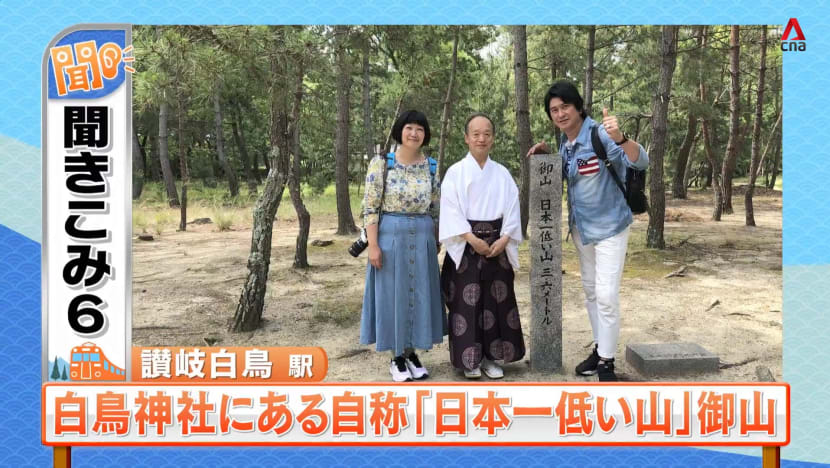Road Trip On Kotoku Line - Part 2

The "lowest mountain" in Japan which is located in a shrine, a restaurant serving giant bell peppers stuffed with meat and a bridge known for its breathtaking view of a river are visited this week.
Our two-day journey of enquiry and discovery on the Kotoku Line in Kagawa and Tokushima prefectures continues. At the end of the first day, we visit the Quataraso Sanuki Tsuda facility attached to the Kuapark Tsuda hotel. It has 13 different types of baths and heated pools, including partial and full-body baths. Water from the hotel’s private hot spring source is used for the full-body baths and bubble baths. There is also an artificial hot spring with mineralised togoal ore and a popular water slide at the heated pool. We try the open-air bath with purified water pumped from the sea in front of the hotel. It boasts a breathtaking view of the Seto Inland Sea.
The next morning, we take the 8.15am train from the Sanuki-Tsuda Station in Kagawa Prefecture and go to the Sanuki-Shirotori Station, four stops away. The ride lasts 15 minutes and the next train from here is at 11.30am. An elderly lady we ask recommends we visit Shirotori Shrine, where there is a pine forest on what is believed to be Japan’s lowest mountain. The shrine worships Yamato Takeru no Mikoto, a deity of martial arts. His spirit is believed to have come down to this place as a white crane and that is how the shrine was established. We head to the shrine to see the mountain, Miyama, which is about 3.6m high.
We “climb” the mountain and reach the summit. Japan has many types of low mountains and Miyama is one of them. The shrine believes it is the lowest mountain in Japan. After this area was hit by floods in 2004, authorities surveyed the land and came across a higher ground that was not flooded. That was how Miyama was discovered. In the following year, the mountain was opened to climbers and promoted as Japan’s lowest mountain. We go to the shrine office to receive a mountain climbing certificate. We are told that a popular souvenir from this area is budou mochi, which is sold at Minatoya Kametsurudo. It is a speciality that was created in the late Edo period. Sweet red bean paste is wrapped with a thin skin and steamed on a stick.
After buying some budou mochi, we take the train to Awa-Kawabata Station in Tokushima Prefecture. We reach at 12.15pm and the next train will leave at 2.45pm. A gentleman we speak to tells us about the Gokurakuji Temple, the second of the 88 Shikoku Pilgrimage temples. There is a shop, Chojuan, which sells pilgrimage equipment such as prayer beads, handbells and walking sticks. Farther east, there is Ryozenji, the first temple and starting point of the Shikoku Pilgrimage.
We find out from the same gentleman that there is a Western restaurant, Gen, which is next to the Ryozenji Temple. He offers to drive us there. At Gen, we order giant green peppers stuffed with minced meat. They are served with a tomato-based dish called caponata. The giant green peppers of Tokushima are about three times bigger than usual green peppers. Bought directly from farmers, they have a subtle sweetness.
After our meal, we take the train to Yoshinari Station, four stops away. We decide to catch the 4.40pm train from here later. A local resident recommends we visit the Shikoku Saburou Bridge. From here, we can see the 194-kilometre-long Yoshino River, which flows from Kochi Prefecture to Tokushima Prefecture. The vast catchment area of the river covers 20 per cent of the Shikoku area.
We finally head to the goal of our two-day trip, Tokushima Station. A local here suggests we eat at Chu Chu Churros, which opened in 2012. It sells churros with a variety of foods such as ice cream. Examples are sudachi sundae, a speciality of Tokushima, and churro sundae with Naruto Kintoki sweet potatoes. Though wheat flour is commonly used for churros, this store use rice flour from Tokushima. So the churros are crispy on the outside and fluffy on the inside.
Another local we ask mentions a shopping street called Poppogai near Tokushima Station. Founded in 1971, it spans nearly 160m and has about 25 stores. They include cosmetic shops, cafes, clothing stores and udon noodle shops. The oldest store on the street is Kendojaya, which belongs to the shopping street’s founder. It used to be a cafe but it is now a restaurant that serves local dishes. After the founder passed away, his wife took over the business. Its speciality is tarai udon, the oldest type of yudame udon. Udon noodles are soaked in hot water and then put in a wooden container. A local dish from Awa City, tarai udon has been around since the late Edo period. In areas where forestry was popular, men who worked in the mountains carried udon noodles in a large container and shared the food with everyone. That is how the dish got started.
Tips:
1) Visit what is believed to be Japan’s lowest mountain at Shirotori Shrine
2) A scenic spot near Yoshinari Station is the Shikoku Saburou Bridge










